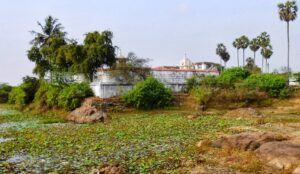
Rock – Cut Temple
Kuranganilmuttam Shivastalam is the 6th of 32 Tevara Stalams in Tamil Nadu. Located in Thiruvannamalai district near the town of Mamandur, this Pallava era rock-cut temple is nearby another unfinished cave temple.
Locally the temple is known as Arulmigu Vaaleeswarar Thirukkovil. It is one of the rock-cut temples excavated by King Mahendravarma, sometimes referred to as Kal mandapam. There are a number of inscriptions from the Krishna Deva Raya era found here.
Because Lord Brahma worshipped Shiva at this place, the temple was originally called Thiruilanathai, and Shiva was known as Koyyamalainathar (‘natha’ referring to Brahma). Valeeswarar is swayambu linga (self-manifesting). His consort is seated on a separate shrine. Lord Brahma is worshipped here as a subsidiary deity.
The temple is associated with a very interesting legend wherein Vaali the monkey (kurangu) worshipped Shiva at the entrance to the temple, while simultaneously Indra in the form of a squirrel (anil) offered worship from the south, and Emadharmaraja (Yamaraja) in the form of a crow (muttam, kaakam) offered worship from the north. This is reflected in the name, ‘Kurang-anil-muttam’. Hanuman is also said to have worshipped Shiva here, and various panels depicting these are found in the temple.
The temple’s sanctum sanctorum is quite small, facing west, with an entrance from the south. Devotees enter through an iron gate, onto a wide campus. There is a courtyard, and on the temple grounds are Sri Poorana Kangana Tharani Theertham, the holy tank, and Ilanthai (Elanndi) as the Kaakai Theertham, or Sthala Vriksa (holy tree).
There are a number of shrines in the courtyard, for Lord Brahma, Mahavishnu, Dakshinamurthi, Bairava, Durga, Sandeswarar, Varasithi Vinayakar, Manthira Ganapathy, Subramaniya with consorts Valli and Theivani, along with Surya, Candra and the Navagraha.
Cave Temple
Located in middle of the village, the cave temple is excavated below the ground level. This characteristic perhaps makes this cave temple unique among the group. It seems that the original rock was scooped out of the ground to make prepare a vertical scarp for the excavation.
It has an interesting layout. Three shrines are excavated from the back wall and four side shrines from its side-walls, two on the side-walls of the ardha and two of the mukha. Thus, it is a rare specimen of a seven-celled rock temple, heralding the elaboration of Dravidian temple plans with numerous subsidiary shrines of future centuries. The Kailasanatha temple with its highly complex architecture in the nearby Pallava capital, Kanchipuram, erected barely one hundred years later, would be one example.
Source:
http://www.harekrsna.com/sun/features/10-09/features1531.htm
http://veludharan.blogspot.in/2014/03/paadal-petra-shiva-sthalangal.html
http://puratattva.in/2010/10/31/kuranganilmuttam-kal-mandakam-cave-temple-32


